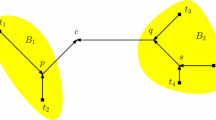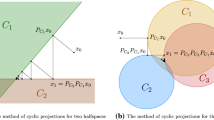Abstract
The yolk, developed in Ferejohn, McKelvey and Packel (1984) and McKelvey (1986), is a key solution concept in the Euclidean spatial model as the region of policies where a dynamic voting game will tend to reside. However, determining the yolk is NP-hard for arbitrary dimension. This paper derives an algorithm to compute the yolk in polynomial time for any fixed dimension.
Similar content being viewed by others
References
J. Bartholdi, N. Narasimhan and C. Tovey, “Recognizing majority-rule equilibrium in spatial voting games,”Social Choice and Welfare 8 (1991) 183–197.
D. Black,The Theory of Committees and Elections (Cambridge University Press, Cambridge, 1958).
O.A. Davis and M.J. Hinich, “A mathematical model of policy formation in a democratic society,” in: J.L. Berndt, ed.,Mathematical Applications in Political Science II (Southern Methodist University, Dallas, TX, 1966).
A. Downs,Economic Theory of Democracy (Harper and Row, New York, 1957).
H. Edelsbrunner, D.G. Kirkpatrick and H.A. Maurer, “Polygonal intersection searching,”Information Processing Letters 14 (1982) 74–79.
H. Edelsbrunner and E. Welzl, “On the number of line-separations of a finite set in the plane,”Journal of Combinatorial Theory Series A 38 (1985) 15–29.
J. Enelow and M. Hinich,The Spatial Theory of Voting (Cambridge University Press, Cambridge, 1984).
P. Erdös, L. Lovasz, A. Simmons and E.G. Straus, “Dissection graphs of planar point sets,” in: J.N. Srivastava et al., eds.,A Survey of Combinatorial Theory (North-Holland, Amsterdam, 1973) pp. 139–149.
P. Erdös and J. Spencer,Probabilistic Methods in Combinatorics (Academic Press, New York, 1974).
S.L. Feld, B. Grofman, R. Hartley, M.O. Kilgour and N.R. Miller, “The uncovered set in spatial voting games,”Theory and Decision 23 (1987) 129–156.
S.L. Feld and B. Grofman, “A theorem connecting Shapley-Owen power scores and the radius of the yolk in two dimensions,”Social Choice and Welfare 7 (1990) 71–74.
S.L. Feld, B. Grofman and N.R. Miller, “Centripetal forces in spatial voting: on the size of the yolk,”Public Choice 59 (1988) 37–50.
S.L. Feld, B. Grofman and N.R. Miller, “Limits on agenda control in spatial voting games,”Mathematical Modelling 12 (1989) 405–416.
J.A. Ferejohn, R. McKelvey and E. Packel, “Limiting distributions for continuous state Markov models,”Social Choice and Welfare 1 (1984) 45–67.
M. Fiorina and C. Plott, “Committee decisions under majority rule: an empirical study,”American Political Science Review 72 (1978) 575–598.
B. Grofman, B. Norrander and S.L. Feld, “U.S. electoral coalitions, 1956–1984,” presented atthe Annual Meeting of the American Political Science Association, Washington, D.C. August 30–September 3, 1988.
M. Hinich, “Some evidence on non-voting models in the spatial theory of electoral competition,”Public Choice 33 (1978) 83–102.
D.S. Johnson and F.P. Preparata, “The densest hemisphere problem,”Theoretical Computer Science 6 (1978) 93–107.
D.H. Koehler, “The size of the yolk: Computations for odd- and even-numbered committees,”Social Choice and Welfare 7 (1990) 231–245.
R.D. McKelvey, “General conditions for global intransitivies in formal voting models,”Econometrica 47 (1979) 1085–1112.
R.D. McKelvey, “Covering, dominance, and institution free properties of social choice,”American Journal of Political Science 30 (1986) 283–314.
N.R. Miller, “A new solution set for tournaments and majority voting,”American Journal of Political Science 24 (1980) 68–96.
N.R. Miller, “The covering relation in tournaments: two corrections,”American Journal of Political Science 27 (1983) 382–385.
G. Nemhauser and L. Wolsey,Integer and Combinatorial Optimization (Wiley, New York, 1988).
C. Plott, “A notion of equilibrium and its possibility under majority rule,”American Economic Review 57 (1967) 787–806.
K. Poole and H. Rosenthal, “A spatial model for legislative roll call analysis,”American Journal of Political Science 29 (1985) 357–384.
K. Poole and H. Rosenthal, “Patterns of congressional voting,”American Journal of Political Science 35 (1991) 228–278.
K. Poole and H. Rosenthal, “Spatial realignment and the mapping of issues in American history: the evidence from roll call voting,” GSIA WP 1990-41, Carnegie-Mellon University (Pittsburgh, PA, 1990).
G. Rabinowitz and E. McDonald, “The power of the states in U.S. presidential elections,”American Political Science Review 80 (1986) 65–89.
A. Rapoport and E. Golan, “Assessment of political power in the Israeli Knessett,”American Political Science Review 79 (1985) 673–692.
A. Rubenstein, “A note about the nowhere denseness of societies having an equilibrium under majority rule,”Econometica 47 (1981) 511–514.
N. Schofield, “Instability of simple dynamic games,”Review of Economic Studies 45 (1978) 575–594.
N. Schofield,Social Choice and Democracy (Springer, Berlin, 1985).
N. Schofield and C. Tovey, “Probability and convergence of equilibrium for spatial supermajority rule,”Mathematical and Computer Modelling 16 (1992).
L.S. Shapley and G. Owen, “Optimal location of candidates in ideological space,”International Journal of Game Theory 1 (1989) 125–142.
A. Schrijver,Theory of Linear and Integer Programming (Wiley, Chichester, 1987).
K.A. Shepsie and B.R. Weingast, “Uncovered sets and sophisticated voting outcomes with implications for agenda institutions,”American Journal of Political Science 28 (1984) 49–74.
R. Stone and C.A. Tovey, “Limiting median lines do not suffice to determine the yolk,”Social Choice and Welfare 9 (1992) 33–35.
C.A. Tovey, “The almost surely shrinking yolk,” Technical Report 150, Center in Political Economy, Washington University (St. Louis, MO, 1990), submitted to:Mathematics of Operations Research.
Author information
Authors and Affiliations
Additional information
Research supported by a Presidential Young Investigator Award from the National Science Foundation (ECS-8451032), and a Senior Research Associateship from the National Research Council.
During the academic year 1990–1991.
Rights and permissions
About this article
Cite this article
Tovey, C.A. A polynomial-time algorithm for computing the yolk in fixed dimension. Mathematical Programming 57, 259–277 (1992). https://doi.org/10.1007/BF01581084
Received:
Revised:
Issue Date:
DOI: https://doi.org/10.1007/BF01581084




